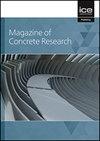钢纤维加固混凝土直接剪切强度的表征建议
IF 1.6
4区 工程技术
Q3 CONSTRUCTION & BUILDING TECHNOLOGY
引用次数: 0
摘要
本研究提出了对带有两个沟槽剪切平面的钢纤维加固混凝土试样进行直接纯剪切表征的方法。最初使用的是卷曲纤维类型,纤维用量在 0.0%、0.5%、1.0% 和 1.5% 之间变化,混凝土抗压强度为 35 兆帕,骨料最大粒径为 9.5 毫米,8 个试件接受了直接剪切试验。结果表明,随着纤维用量的增加,剪切强度明显提高,纤维用量为 1.5%时,剪切强度提高了 90%。根据这些观察结果,制定了三个分析表达式来计算剪切应力。模型的验证应用于 15 块同样小尺寸几何形状的砌块组,并将钩端纤维、25 兆帕的混凝土抗压强度、粗骨料的类型和最大尺寸(19 毫米和 25 毫米)作为附加变量。与钩端纤维相比,卷曲纤维具有良好的性能,在最大粗骨料粒径为 25 毫米的情况下,以 1.5%的比率计算,强度提高了约 100%,在拟议的分析模型中显示出 2% 到 7% 之间的变化。本文章由计算机程序翻译,如有差异,请以英文原文为准。
Characterisation proposal of direct shear strength of steel fibre-reinforced concrete
This study proposes the direct pure shear characterisation of steel fibre-reinforced concrete specimens with two grooved shear planes. Initially, the crimped fibre type was used with a rate varying between (0.0 %, 0.5 %, 1.0 %, and 1.5%), a concrete compressive strength of 35 MPa, a maximum aggregate size of 9.5 mm, and eight specimens subjected to the direct shear test. The results showed a significant gain in shear strength with increased fibre consumption, 90% at a rate of 1.5%. Based on these observations, three analytical expressions were formulated to compute the shear stress. The validation of the models was applied to a group of fifteen blocks of the same smaller size geometry and had as additional variables the hooked-end fibre, the concrete compressive strength of 25 MPa, the type and the maximum size of the coarse aggregate (19 mm and 25 mm). Crimped fibre confirmed good performance compared to the hooked-end, with a strength gain of around 100% at a rate of 1.5% with the maximum coarse aggregate particle size of 25 mm, showing variability between 2 and 7% in the proposed analytical models.
求助全文
通过发布文献求助,成功后即可免费获取论文全文。
去求助
来源期刊

Magazine of Concrete Research
工程技术-材料科学:综合
CiteScore
4.60
自引率
11.10%
发文量
102
审稿时长
5 months
期刊介绍:
For concrete and other cementitious derivatives to be developed further, we need to understand the use of alternative hydraulically active materials used in combination with plain Portland Cement, sustainability and durability issues. Both fundamental and best practice issues need to be addressed.
Magazine of Concrete Research covers every aspect of concrete manufacture and behaviour from performance and evaluation of constituent materials to mix design, testing, durability, structural analysis and composite construction.
 求助内容:
求助内容: 应助结果提醒方式:
应助结果提醒方式:


